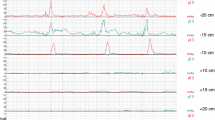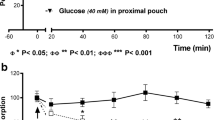Abstract
To further characterize colonic motility in the dog and to examine the effects of intraluminal contents, motor activity in conscious animals was recorded by perfused intraluminal catheters. Animals were studied first with the bowel intact and, later, the colon was fashioned into an isolated loop. In the fasting state, cycles of motility recurred approximately each 30 min. These consisted of sequences of phasic contractions (bursts) that migrated variable distances in either direction; stationary bursts were also recorded. The fasting patterns recorded from intact bowel and isolated loops were not different. Feeding increased colonic motility, and the mean periodicity of cyclic bursts was reduced significantly to approximately 20 min. Moreover, differences were observed between intact bowel and isolated loops in the postprandial period. Diversion of chyme from the colon significantly reduced the motor response to food, but only in the late (2– 4 hr) postprandial period, when the less frequent, fasting cycle returned to the loops. Perfusion of isolated loops with chyme or saline reestablished the postprandial pattern seen in intact bowel. The results suggest that the volume, but not the composition, of luminal contents modify postprandial motility in the canine colon. Additional experiments confirmed that, in particular, volatile fatty acids were probably not important determinants of colonic motility in the dog.
Similar content being viewed by others
References
Templeton RD, Lawson H: Studies in the motor activity of the large intestine. I. Normal motility in the dog recorded by the tandem balloon method. Am J Physiol 96:667–676, 1931
Welch PB, Plant OH: A graphic study of the muscular activity of the colon, with special reference to its response to feeding. Am J Med Sci 172:261–268, 1926
Schuurkes JAJ, Tukker JJ: The interdigestive colonic motor complex of the dog. Arch Int Pharmacodyn Ther 247:329–334, 1980
Bueno L, Fioramonti J, Ruckebusch M: Comparative effects of morphine and nalorphine on colonic motility in the conscious dog. Eur J Pharmacol 75:239–245, 1981
Fioramonti J, Bueno L: Diurnal changes in colonic motor profile in conscious dogs. Dig Dis Sci 28:257–264, 1983
Fioramonti J, Garcia-Villar R, Bueno L, Ruckebusch Y: Colonic myoelectrical activity and propulsion in the dog. Dig Dis Sci 25:641–646, 1980
Sarna SK, Condon R, Cowles V: Colonic migrating and nonmigrating motor complexes in dogs. Am J Physiol 246:G355-G360, 1984
Sarna SK, Lang JM: Effect of a meal on colonic motor complexes: Gastrocolonic response. Gastroenterology 88: 1571, 1985 (abstract)
Sarna SK: Myoelectric correlates of colonic motor complexes and contractile activity. Am J Physiol 250:G213-G220, 1986
Burrows CF, Merritt AM: Influence of α-cellulose on myoelectric activity of proximal canine colon. Am J Physiol 245:G301-G306, 1983
Fioramonti J, Bueno L: Motor activity in the large intestine of the pig related to dietary fibre and retention time. Br J Nutr 43:155–162, 1980
Cherbut G, Ruckebusch Y: Modifications de l'electromyogramme du cÔlon lieés a l'ingestion de particules non digestibles chez le chien. Gastroenterol Clin Biol 8:955–959, 1984
Tansy MF, Kendall FM: Experimental and clinical aspects of gastrocolic reflexes. Dig Dis Sci 18:521–531, 1973
Collin J, Kelly KA, Phillips SF: Enhancement of absorption from the intact and transected canine small intestine by electrical pacing. Gastroenterology 76:1422–1428, 1979
Kamath PS, Hoepfner MT, Phillips SF: Short chain fatty acids stimulate motility of the canine ileum. Am J Physiol 253:G427-G433, 1987
Quigley EMM, Phillips SF, Dent J, Taylor BM: Myoelectric activity and intraluminal pressure of the canine ileocolonic sphincter. Gastroenterology 85:1054–1062, 1983
Atanassova E, Noeva A, Gachilova S: Relationship between the spike activities of the small and large intestines. Dig Dis Sci 30:757, 1985 (abstract)
Christensen J, Anuras S, Hansen RL: Migrating spike bursts and electrical slow waves in the cat colon: Effect of sectioning. Gastroenterology 66:240–247, 1974
Author information
Authors and Affiliations
Additional information
Supported in part by grants AM 32121, AM 34988, and RR 585 from the National Institutes of Health, Bethesda, Maryland.
Dr. Flourie was supported in part by grants from the French Government and the Fondation pour la Recherche Medicale.
Rights and permissions
About this article
Cite this article
Flourie, B., Phillips, S., Richter, H. et al. Cyclic motility in canine colon: Responses to feeding and perfusion. Digest Dis Sci 34, 1185–1192 (1989). https://doi.org/10.1007/BF01537266
Received:
Revised:
Accepted:
Issue Date:
DOI: https://doi.org/10.1007/BF01537266




